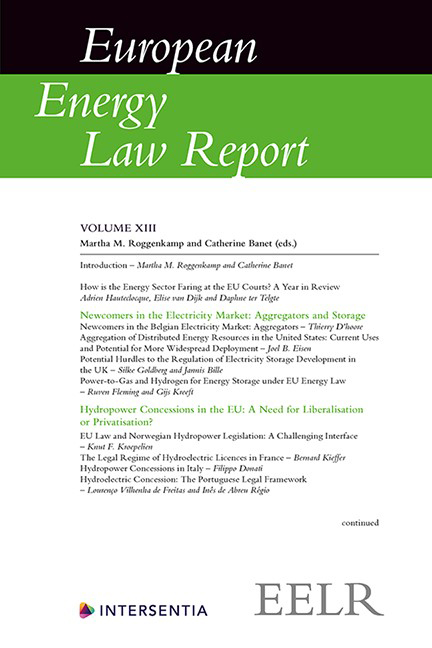Book contents
- Frontmatter
- Preface
- Contents
- List of Abbreviations
- List of Contributors
- Introduction
- Chapter I How is the Energy Sector Faring at the EU Courts? A Year in Review
- PART I NEWCOMERS IN THE ELECTRICITY MARKET: AGGREGATORS AND STORAGE
- PART II HYDROPOWER CONCESSIONS IN THE EU: A NEED FOR LIBERALISATION OR PRIVATISATION?
- PART III INVESTMENTS AND DISINVESTMENTS IN THE ENERGY SECTOR
- PART IV OFFSHORE DECOMMISSIONING IN THE NORTH SEA
- PART V CCS AS A CLIMATE TOOL: NORTH SEA PRACTICE
- PART VI FROM EU CLIMATE GOALS TO NATIONAL CLIMATE LAWS
Chapter III - Aggregation of Distributed Energy Resources in the United States: Current Uses and Potential for More Widespread Deployment
Published online by Cambridge University Press: 30 April 2020
- Frontmatter
- Preface
- Contents
- List of Abbreviations
- List of Contributors
- Introduction
- Chapter I How is the Energy Sector Faring at the EU Courts? A Year in Review
- PART I NEWCOMERS IN THE ELECTRICITY MARKET: AGGREGATORS AND STORAGE
- PART II HYDROPOWER CONCESSIONS IN THE EU: A NEED FOR LIBERALISATION OR PRIVATISATION?
- PART III INVESTMENTS AND DISINVESTMENTS IN THE ENERGY SECTOR
- PART IV OFFSHORE DECOMMISSIONING IN THE NORTH SEA
- PART V CCS AS A CLIMATE TOOL: NORTH SEA PRACTICE
- PART VI FROM EU CLIMATE GOALS TO NATIONAL CLIMATE LAWS
Summary
INTRODUCTION
Aggregation of distributed energy resources (DERs) in the United States can be an important component of a revolutionary energy transition that integrates significant new quantities of DERs in the electric grid and transforms end users from energy consumers into energy producers and managers. The term ‘distributed energy resources’ encompasses a wide variety of small-scale distributed generation units such as rooftop solar panels, as well as electric vehicles, ‘demand response’’, and energy storage, among others. The principal characteristic all DERs share is their location at the edge of the electric grid. This chapter uses the definition of DER from the U.S. Federal Energy Regulatory Commission (FERC), which is: ‘[a]ny source or sink of power that is located on the distribution system, any subpart thereof, or behind a customer meter.’
DERs are connecting to the American electric grid in ever-growing numbers, and can provide significant flexibility and resilience benefits to the grid. They can serve as the equivalent of conventional power plants, providing electricity in wholesale energy, capacity and ancillary services markets. At the distribution level, they can help defer or replace more costly investments in traditional grid infrastructure. And DERs can help integrate renewable resources into the grid and decrease greenhouse gas emissions.
DERs present new challenges to an American electric grid that until recently relied heavily on central generating stations and long-distance transmission lines to serve customers. Evolving from the grid of the past to relying on a myriad of DERs, and taking full advantage of their unique characteristics, requires new paradigms for utilities, grid operators, and regulators. As deployment grows, the operation of DERs can interact with both the bulk power system, which is managed by wholesale market operators subject to federal regulation, and the distribution system, which is managed by utilities subject to state regulation. Careful management of the impacts of thousands of new DERs on distribution systems is therefore necessary, as is development of wholesale market models to allow DERs to meet grid needs.
Some of the many challenges to full integration of DERs in the electric grid may be addressed through aggregation. ‘Aggregation’ means combining DERs from a diverse array of end users into a single resource through the use of systems that remotely and automatically combine and optimize generation, demand-side, and storage resources.
- Type
- Chapter
- Information
- European Energy Law Report XIII , pp. 57 - 78Publisher: IntersentiaPrint publication year: 2020

